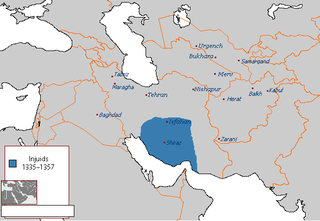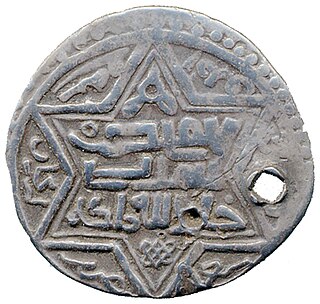
The Muzaffarid dynasty was a Muslim dynasty which came to power in Iran following the breakup of the Ilkhanate in the 14th century. At their zenith, they ruled a kingdom comprising Iranian Azerbaijan, Central Persia, and Persian Iraq. The Muzaffarids were known for their support of Arabic literature. Shah Shoja was a poet and wrote in both Arabic and Persian and was said to be capable of memorizing eight verses of Arabic poetry after hearing them read once. While the Muzaffarid ruler of Kirman, Shah Yahya, commissioned the scholar Junyad bin Mahmud Al-Umari to compile an anthology of Arabic poetry and prose for him
Amir Chūpān, also spelt Choban or Coban, was a Chupanid noble of the Ilkhanate, and nominal general of the Mongol Empire. He was ennobled by Emperor Taiding of Yuan as Duke of Yi (翊國公).
Baghdad Khatun, was a Chobanid princess, the daughter of Chupan. She was the empress consort of the Ilkhanate as the wife of Abu Sa'id Bahadur Khan.

The Chobanids or the Chupanids were descendants of a Mongol family of the Suldus clan that came to prominence in 14th century Persia. At first serving under the Ilkhans, they took de facto control of the territory after the fall of the Ilkhanate. The Chobanids ruled over Azerbaijan, Arrān, parts of Asia Minor, Mesopotamia, and west central Persia, while the Jalayirids took control in Baghdad.
Hasan Kuchak or Ḥasan-i Kūchik was a Chupanid prince during the 14th century. He is credited with setting up a nearly independent Chupanid state in Iran during the struggles taking place in the aftermath of the Ilkhanate. He effectively became kingmaker like his namesake Hasan Buzurg.
Dilshad Khatun, also Delshad, was a Chobanid princess. She was the wife of Ilkhan Abu Sa'id Bahadur Khan, and after him Hasan Buzurg, the first ruler of the Jalayirid Sultanate, and the mother of his son and successor Shaikh Awais.

The Injuids were an Iranian dynasty of Persian origin that came to rule over the cities of Shiraz and Isfahan during the 14th century. Its members became de facto independent rulers following the breakup of the Ilkhanate until their defeat in 1357.
Shaikh Hasan, also known as "Hasan Buzurg", Hassan the Jalair or Hassan-e Uljatâï was the first of several de facto independent Jalayirid rulers of Iraq and central Iran.

Shaykh Uways Jalayir was the Jalayirid ruler of Iraq (1356–1374) and Azerbaijan (1360–1374). He was the son of Hasan Buzurg and the Chobanid princess Dilshad Khatun.

The Sarbadars were a mixture of religious dervishes and secular rulers that came to rule over part of western Khurasan in the midst of the disintegration of the Mongol Ilkhanate in the mid-14th century. Centered in their capital of Sabzavar, they continued their reign until Khwaja 'Ali-yi Mu'ayyad submitted to Timur in 1381, and were one of the few groups that managed to mostly avoid Timur's famous brutality.
Muhammad Khan was a claimant to the throne of the Ilkhanate.
Sati Beg was an Ilkhanid princess, the sister of Il-Khan Abu Sa'id (r. 1316–1333). She was the consort of amir Chupan (1319–1327), Il-Khan Arpa (r. 1335–36), and Il-Khan Suleiman (r. 1339–1343). In 1338–39, she was briefly the Ilkhanid khatun during internal conflicts, appointed by a Chobanid faction led by Hassan Kuchak.
Suleiman Khan was a Chobanid puppet for the throne of the Ilkhanate during the breakdown of central authority in Persia.
Jahan Temür was a Jalayirid puppet for the throne of the Ilkhanate in the late 1330s.
Malek Ashraf, was a Chupanid ruler of northwestern Iran during the 14th century. He was the last of the Chupanids to possess a significant influence within Ilkhanate.

The Jalayirid Sultanate was a Mongol Jalayir dynasty which ruled over modern-day Iraq and western Iran after the breakup of the Mongol khanate of Persia in the 1330s. It lasted about fifty years, until disrupted by Timur's conquests and the revolts of the Qara Qoyunlu Turkoman. After Timur's death in 1405, there was a brief attempt to re-establish the sultanate in southern Iraq and Khuzistan. The Jalayirids were finally eliminated by the Qara Qoyunlu in 1432.

Togha Temür, also known as Taghaytimur, was a claimant to the throne of the Ilkhanate in the mid-14th century. Of the many individuals who attempted to become Ilkhan after the death of Abu Sa'id, Togha Temür was the only one who hailed from eastern Iran, and was the last major candidate who was of the house of Genghis Khan. His base of power was Gurgan and western Khurasan. His name "Togoy Tomor" means "Bowl/Pot Iron" in the Mongolian language.
Wajih ad-Din Mas'ud was the leader of the Sarbadars of Sabzewar from 1338-1343 until his death. Under his rule, the Sarbadar state developed its characteristic dual nature as both a secular and radical Shi'i state.

ʿAlāʾ al-Dīn Eretna was the first Sultan of the Eretnids, reigning between 1343–1352 in central and eastern Anatolia. Initially an officer in the service of Chupan and his son Timurtash, he migrated to Anatolia following the latter's appointment as the Ilkhanid governor of the region. He took part in his master Timurtash's campaigns to subdue the Turkoman chiefs of the western periphery of the peninsula. This was cut short by Timurtash's downfall, after which Eretna went into hiding. Upon the dissolution of the Ilkhanate, he aligned himself with the Jalayirid leader Hasan Buzurg, who eventually left Anatolia for Eretna to govern when he returned east to clash with the rival Chobanids and other Mongol lords. Eretna later sought recognition from the Mamluk Egypt to consolidate his power, although he played a delicate game of alternating his allegiance between the Mamluks and the Mongols. In 1343, he declared independence as the sultan of his domains. His reign was largely described to be prosperous with his efforts to maintain order in his realm such that he was known as Köse Peyghamber.
Jahan Malek Khatun was an Injuid poet and princess. She wrote under pen name Jahān and was a contemporary of the poet Hafez.